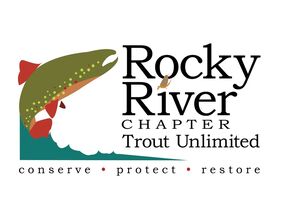Boy Scouts of America (BSA) Merit Badge Counselor Assistants
Rocky River Trout Unlimited members that have an interest in scouting may participate in district scouting merit badge events. Whether you have the experience to be a Fly Fishing Merit Badge Counselor Assistant or less experience to be a Fishing Merit Badge Counselor, the Boy Scouts of America needs your help. As scheduling becomes available to the Chapter, we will announce the opportunities to participate. The requirements for the two merit badges that we can provide leadership and assists follows:
Fly Fishing Merit Badge requirements
- A Special Note: Scientist, author, Vietnam veteran, 30-year retired fisheries biologist with U.S. Fish and Wildlife Service and lifelong fly fisher Dr. Robert J. Sousa, of Bristol, Rhode Island, was awarded the highest conservaton recognition bestowed by the Boy Scouts of America, the William T. Hornaday Gold Metal. The award is the oldest continuous conservation award by any organization in the United States. He originated the Fly Fishing Merit Badge.
- Explain to your counselor the injuries that could occur while fly-fishing
and the proper treatment, including cuts, scratches, puncture
wounds, insect bites, hypothermia, and heat reactions. Explain how to remove a hook that has lodged in your arm. Name
and explain five safety practices you should always follow while fly-fishing. - Discuss how to match a fly rod, line and leader to get a balanced system.
Discuss several types of fly lines, and explain how and when each would be used.
Review with your counselor how to care for this equipment. - Demonstrate how to tie proper knots to prepare a fly rod for fishing:
a. Tie a backing to a fly reel spool using the arbor backing knot
b. Attach backing to fly line using the nail knot
c. Attach a leader to fly line using the needle knot, nail knot or loop-to-loop connection
d. Add tippet to a leader using a double surgeon’s loop or blood knot
e. Tie a fly onto the terminal end of the leader using the improved clinch knot - Explain how each of the following types of flies are used: dry flies, wet flies, nymphs, streamers, bass bugs, and poppers. What does each imitate? Tie at least two types of the flies mentioned in this requirement.
- Demonstrate the ability to cast a fly consistently and accurately using overhead and roll cast techniques.
- Go to a suitable fishing location and make observations on the types of insects fish may be eating. Look for flying insects and some that may be on or beneath the water’s surface. Look under rocks. Explain the importance of matching the hatch.
- Explain the importance of practicing Leave No Trace and how it positively affects fly-fishing resources.
- Obtain a copy of the regulations affecting game fishing where you live. Explain why they were adopted and what you accomplish by following them.
- Explain what good outdoor sportsmanlike behavior is and how it relates to fishermen. Tell how the Outdoor Code of the Boy Scouts of America relates to a fishing enthusiast, including the aspects of littering, trespassing, courteous behavior, and obeying fishing regulations.
- Using the fly-fishing techniques you have learned, catch two different kinds of fish and identify them. Release at least one of them unharmed. Clean and cook another fish.
Fishing Merit Badge requirements
1. Do the following:
a. Explain to your counselor the most likely hazards you may encounter while participating in fishing activities, and what you should do to
anticipate, help prevent, mitigate, and respond to these hazards.
b. Discuss the prevention of and treatment for the following health concerns that could occur while fishing, including cuts and scratches,
puncture wounds, insect bites, hypothermia, dehydration, heat exhaustion, heatstroke, and sunburn.
c. Explain how to remove a hook that has lodged in your arm.
d. Name and explain five safety practices you should always follow while fishing.
2. Discuss the differences between two types of fishing outfits. Point out and identify the parts of several types of rods and reels. Explain how
and when each would be used. Review with your counselor how to care for this equipment.
3. Demonstrate the proper use of two different types of fishing equipment.
4. Demonstrate how to tie the following knots: clinch, Palomar, turle, blood loop (barrel knot), and double surgeon's loop. Explain how and when
each knot is used.
5. Name and identify five basic artificial lures and five natural baits and explain how to fish with them. Explain why bait fish are not to be
released.
6. Do the following:
a. Explain the importance of practicing Leave No Trace techniques. Discuss the positive effects of Leave No Trace on fishing resources.
b. Discuss the meaning and importance of catch and release. Describe how to properly release a fish safely to the water.
7. Obtain and review the regulations affecting game fishing where you live. Explain why they were adopted and what you accomplish by
following them.
8. Explain what good outdoor sportsmanlike behavior is and how it relates to anglers. Tell how the Outdoor Code of the Boy Scouts of America
relates to a fishing sports enthusiast, including the aspects of littering, trespassing, courteous behavior, and obeying fishing regulations.
9. Catch at least one fish. If regulations and health concerns permit, clean and cook a fish you have caught. Otherwise, acquire a fish and cook it.
